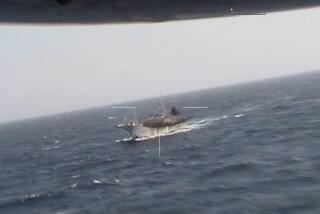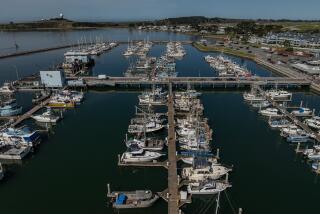Environment : Dolphins Against Nets: The War Isn’t Over Yet : Savoring victory in their campaign against U.S. tuna canners, environmentalists are mobilizing on new fronts. Drift nets and the European market are the next targets.
The 20-year campaign to rescue the dolphins is far from over.
In the most significant step since passage of the Marine Mammal Protection Act of 1972, the three major U.S. tuna canners, led by StarKist Seafood Co., have vowed to stop buying tuna that environmentalists consider “tainted” by any of several fishing techniques that collectively drown an estimated 100,000 dolphins a year.
“This was a shot heard round the world,” said a gratified David Phillips, director of Earth Island Institute. Any country encouraging its fishing fleet to use such methods, said Phillips, “just saw the market drop out from under them, saw the biggest company in the world close the market to them. . . . It really has created a whole new ball game.”
But while environmentalists savor their victory, they are also nailing down the details of the tuna packers’ pledge and laying plans for new fishing-related campaigns.
“The battle moves now to the drift net, which is a major, global issue . . . much bigger than the connection to the tuna industry,” said Barbara Britten after a recent meeting in Washington of the Dolphin Coalition, an ad hoc group of more than 30 conservation organizations. Britten is Washington representative of the oldest dolphin and whale conservation group in the world, the San Pedro-based American Cetacean Society.
Drift nets are a form of gill net--monofilament webs that snag fish by the gills. The drift nets are transparent, free-floating curtains that can stretch for 30 miles, entangling dolphins, whales, turtles, birds and non-food fish as well as the squid, swordfish and other marketable species that the fishermen seek. Environmentalists consider this the most destructive fishing technique ever invented. They commonly term it strip-mining of the sea. According to some estimates, from 50% to 70% of the animals killed in drift nets are simply thrown back into the sea.
Marine biologists say they have no idea how many dolphins drown in high-seas drift nets, but Robert L. Brownell Jr., chief of the marine mammals section of the National Ecology Research Center at San Simeon, said that the number “batted around” is 50,000 to 100,000. About the same number, he adds, are thought to be killed annually in gill nets set in coastal waters.
StarKist has long refused to buy tuna known to have been caught in drift and gill nets. Its recent announcement was to extend that voluntary ban to include fish caught in giant purse-seine nets in the Eastern Tropical Pacific. For reasons scientists can’t explain, dolphins often swim over schools of particularly large tuna in that specific area. Fishermen look for dolphin to signal the presence of tuna below, then surround the fish with these nets, which resemble upside-down lampshades. As the net is cinched closed at the bottom to bring the fish to the surface, the air-breathing dolphin often become snared as well, drowning after only about four minutes trapped underwater. Others are injured and killed in the rigging and gears used to pull in the net.
The battle to stop this practice of “fishing on dolphin” will now move to Europe, second-largest canned tuna market after the United States.
“The work (immediately) ahead of us,” said Lesley Scheele, international dolphin coordinator for Greenpeace, “is ensuring that we don’t simply create a dolphin-safe market in the United States, only to see dolphin-tainted tuna flooding the market in Europe.”
Gloomy U.S. tuna fishermen, who have depended on purse-seine nets, predict that foreign boats will move in on the waters vacated by the American fleet and concentrate on selling their catch to the European market.
Greenpeace will try to marshal the same kind of international consumer pressure that brought U.S. tuna canners to heel, using its 20 offices and some 1.5 million supporters who are already at work in Europe. Greenpeace is also targeting Australia and other lesser markets for consumer-education efforts.
Meanwhile, Barbara Britten and other members of the Dolphin Coalition think the StarKist pledge will help their principal campaign--support for pending federal legislation, introduced by California Rep. Barbara Boxer (D-Millbrae) and Sen. Joseph R. Biden Jr. (D-Del.), to require “dolphin-safe” and “dolphin-unsafe” labels on tuna sold in the United States.
Although pleased by the StarKist plan, in which the company will apply its own dolphin-safe label, the coalition prefers a mandatory program over a voluntary plan “which may not be enforceable,” said Britten.
Other environmentalists are more optimistic about voluntary efforts. “At this point, we think (the StarKist plan) will be enforceable,” said Scheele of Greenpeace.
A highly regulated tuna-tracking system is already in place, mandated by the Marine Mammal Protection Act and the U.S. Food and Drug Administration, in case a batch of tuna need ever be recalled. In many cases, it’s possible to trace the contents of a can back to the specific vessel that caught the fish, using identification numbers on every container.
The system of requiring onboard observers to report dolphin deaths came in for criticism following reports of harassment by boat crews and bribery to falsify records. But there have been reforms of the system--which covers all U.S. tuna boats and about 30% of the foreign fleet--and most environmental groups say they seem to be working.
“Most of the observers are either U.S., or U.S.-trained by the National Marine Fisheries Service,” said Britten.
Just to be on the safe side, the Redondo Beach-based Sea Shepherd Society intends to offer a $5,000 reward to any fisherman who documents that a colleague used questionable fishing methods for tuna that ends up in any can marketed by StarKist or the other major U.S. canners that joined its pledge--Bumble Bee and Chicken of the Sea. The group plans to advertise the reward in publications in San Diego and Costa Rica and is trying to buy a boat to observe fishing in the Eastern Tropical Pacific.
In June, Sea Shepherd will sail the group’s existing vessel, a former fishing trawler, into the North Pacific, to protest drift-net fishing. The group will either sink or “confiscate” any nets they find, according to Scott Triminham, Sea Shepherd president, on grounds that their use allegedly violates international fishing treaties.
Last December, the United Nations resolved to beef up studies of the impact of drift nets on the world’s oceans, to curtail use in some places, and to impose a moratorium beginning in 1992 unless “effective conservation and management measures” were taken.
“Our fear is that in some places, drift nets have been so destructive already that there are no more animals to study,” said Nancy Daves Hicks, director of government affairs for the Animal Protection Institute, headquartered in Sacramento. Hicks and others wanted to see a more vigorous stand by the U.N. “Our position is that effective conservation measures is stopping the use of drift nets.”
New Zealand, the Federated States of Micronesia, the Maldives, Fiji and other oceanic nations aren’t waiting for more study. They’ve already banned drift nets from their territorial waters. A 1987 U.S. law only requires that the impact of drift-net fishing be assessed and that U.S. agencies try to negotiate bans and observation programs with other nations.
The Japanese, who annually harpoon almost 40,000 of a particularly endangered type of dolphin called Dall’s porpoise, have announced that they will continue fishing with drift nets, and both South Korea and Taiwan also have large drift-net fleets.
Coastal gill nets wreak havoc on dolphins worldwide, but particularly in the Sea of Cortez, in Mexico, and off Sri Lanka. Gill nets are now banned along the Pacific coast from the Alaskan-Canadian border to the middle of California, as well as in New York, Texas, and such Great Lakes states as Minnesota, Michigan and Indiana.
The last stretch of California coastline would join the ban under a proposed initiative for the November ballot sponsored by Assemblywoman Doris Allen (R-Cypress).






